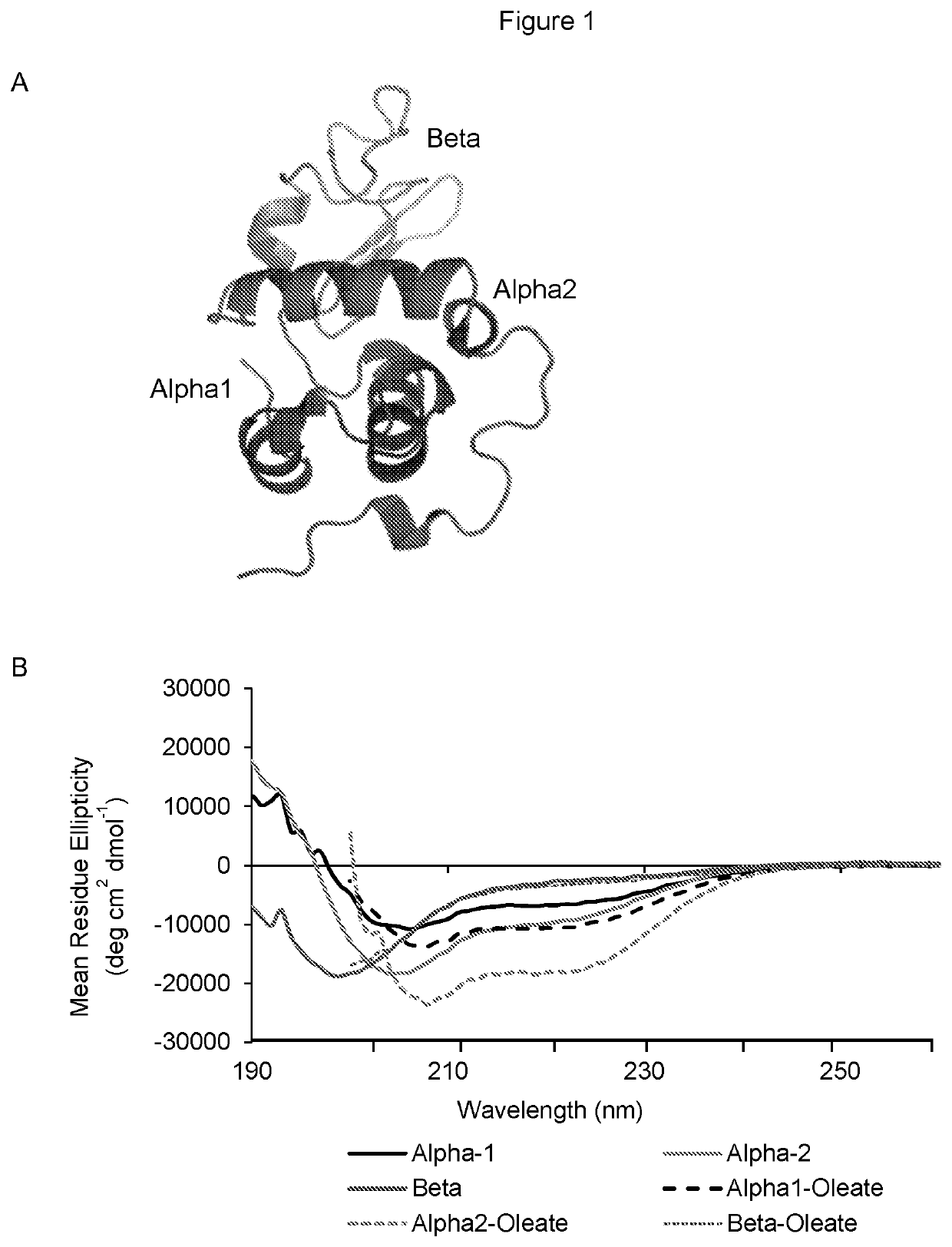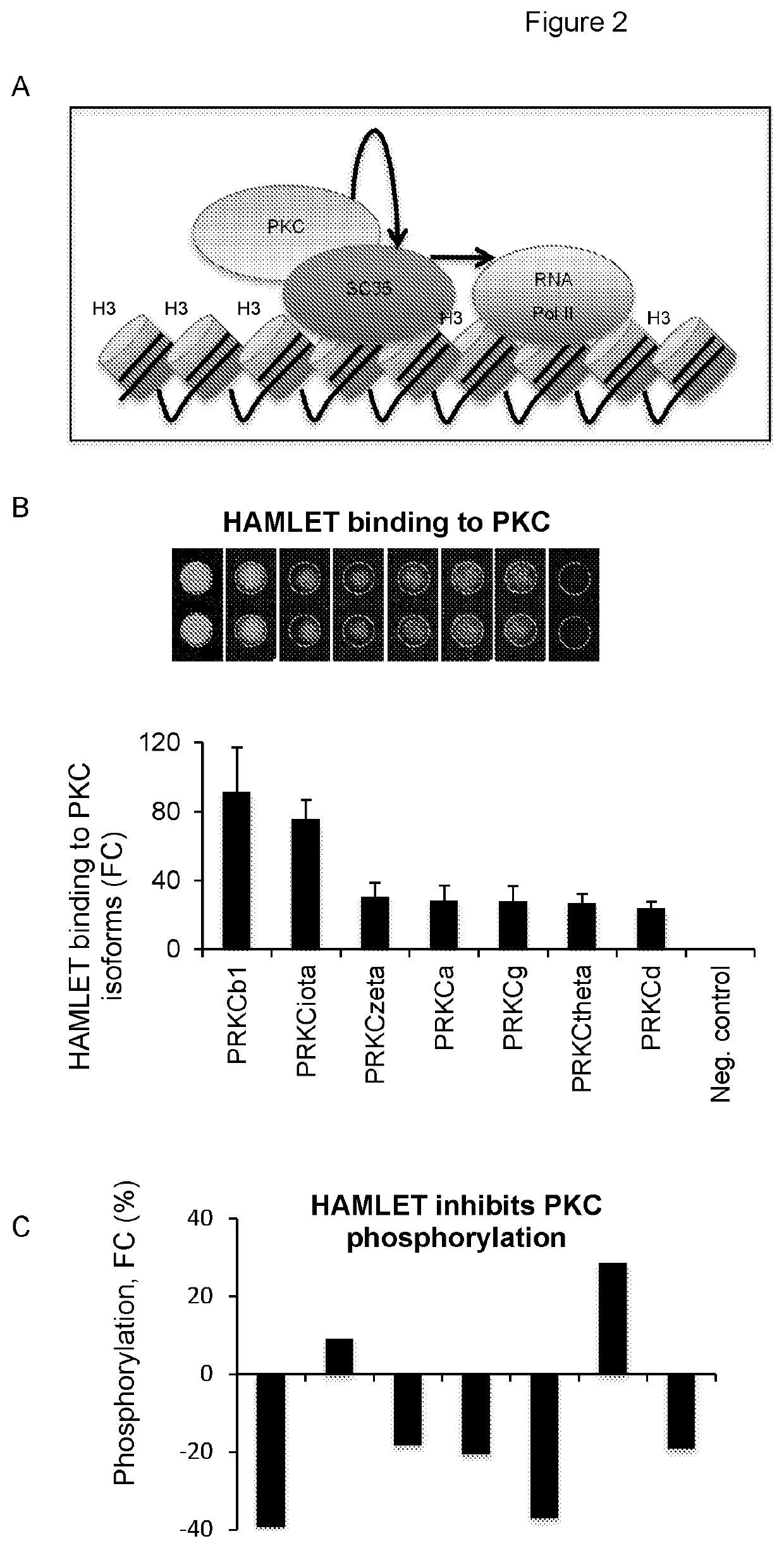Therapeutically active complexes
a complex and active technology, applied in the field of therapeutically active complexes, can solve the problems of skepticism about tumor specific cell death and notion of new, and achieve the effects of reducing tumor size, inhibiting pol ii activation, and preventing the dissociation of bound components
- Summary
- Abstract
- Description
- Claims
- Application Information
AI Technical Summary
Benefits of technology
Problems solved by technology
Method used
Image
Examples
example 1
Illustrative Example 1
HAMLET is Internalized Into Two Distinct Populations of Tumor Cells
[0092]During live cell imaging of Alexa-Fluor labeled HAMLET (35 μM, 1 hour) and adherent lung carcinoma cells (A549), two distinct cellular staining patterns (FIG. 1a) were detected. Population I (51%) showed membrane blebbing, diffuse cytoplasmic staining and accumulation of HAMLET in nuclear speckles, defined by staining with antibodies to the nuclear speckle marker SC-35. Nuclear speckles reside in the inter-chromatin space of eukaryotic nuclei and serve as important nodes in the splicing of pre-mRNA and transport of spliced RNA. In Population II (47%), staining was exclusively cytoplasmic with uptake into vesicles defined as lysosomes. By Western blot analysis of whole-cell extracts, the uptake of HAMLET was shown to be time- and dose dependent.
example 2
Illustrative Example 2
Peptides Determine the Cellular Distribution of HAMLET
[0093]To examine if specific protein domains explain these patterns, synthetic peptides corresponding to the alpha1 domain (residues 1-39) (SEQ ID NO 1), the beta sheet (40-80) (SEQ ID NO 2) or the alpha2 domain (SEQ ID NO 3) (residues 81-123) of alpha-lactalbumin, but lacking in cysteine residues; the globular, 14.2kDa protein constituent of HAMLET (FIG. 1a) were used. Synthetic alpha1- and alpha2-peptides retained a high percentage of alpha helical secondary structure with or without bound oleate. The beta-peptide gained alpha-helical properties when in complex with oleate (FIG. 1b).
[0094]As oleate complexes, the alpha1- and alpha2 peptides reproduced the Population I phenotype, with membrane blebbing, diffuse cytoplasmic staining and accumulation in nuclear speckles (FIG. 1c-d). The initial membrane integration phase was peptide-specific but the subsequent internalization and nuclear accumulation of the a...
example 3
Illustrative Example 3
Effects of Alpha-Helical Peptide-Oleate Complexes on Nuclear Speckle Constituents
[0096]Peptide-specific targets were subsequently identified in the nuclear speckles of Population I. Based on imaging data, McCuaig et al Frontiers in immunology 6, 562, doi:10.3389 / fimmu.2015.00562 (2015) have constructed a hypothetical model, which predicts that PKC phosphorylates SC-3 5, which then activates the phosphorylation of RNA polymerase II (RNA Pol II) at Serine 2 (Ser2), (FIG. 2a). The applicants therefore hypothesized that HAMLET and the alpha-peptides modify the speckle environment by direct interactions with speckle constituents, which are critical for transcriptional activity, including protein kinase C (PKC) and RNA Polymerase II (Pol II).
[0097]In a proteomic screen of 8000 human proteins reported previously (Satoh, J. et al., Journal of neuroscience methods 152, 278-288, doi:10.1016 / j.jneumeth.2005.09.015 (2006), the known affinity of HAMLET for histone H3 was co...
PUM
| Property | Measurement | Unit |
|---|---|---|
| temperature | aaaaa | aaaaa |
| concentration | aaaaa | aaaaa |
| pH | aaaaa | aaaaa |
Abstract
Description
Claims
Application Information
 Login to View More
Login to View More - R&D
- Intellectual Property
- Life Sciences
- Materials
- Tech Scout
- Unparalleled Data Quality
- Higher Quality Content
- 60% Fewer Hallucinations
Browse by: Latest US Patents, China's latest patents, Technical Efficacy Thesaurus, Application Domain, Technology Topic, Popular Technical Reports.
© 2025 PatSnap. All rights reserved.Legal|Privacy policy|Modern Slavery Act Transparency Statement|Sitemap|About US| Contact US: help@patsnap.com



